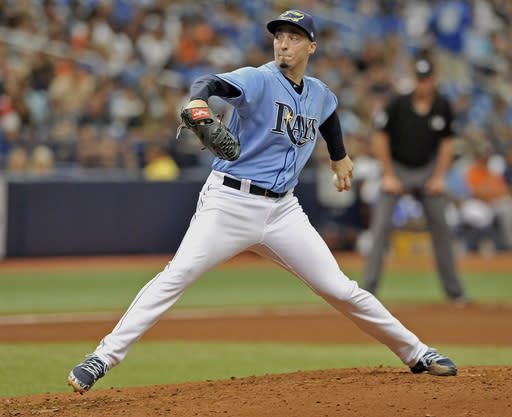Buying or selling first half's most surprising pitchers in fantasy

After looking at the most surprising hitters at the halfway point, let’s look at the top pitching values, according to TGFantasy’s calculator (12-team mixed league, $260 budget, 33% on pitching). Most of the stats courtesy of our friends at MLB stat provider Inside Edge.
Blake Snell comes in through Monday at $30, the fifth most valuable starting pitcher. I hate working behind in the count and that and command lands Snell below average. He’s especially bad at strike percentage on fastballs (59% compared with league average of 65%). As a result he’s also well below average in plate appearances below four pitches. But his stuff makes up for inefficiency as his well-hit average of at bats is .109 vs. MLB average of .163. And he doesn’t even need to make hitters chase as his well-hit average on strikes is also far better than the league average. Plus 23% of his strikes are swinging compared to the league average of 17%. As we said previously, his ability to convert quality starts into wins on a bad team is unlikely to continue. His 11 wins are huge right now in his valuation. I’d be surprised if he got more than six the rest of the way. So he’ll be about a $20 pitcher. This makes him a sell, even if we buy the peripherals.
Trevor Bauer ($26, 9th) is crushing Ks and the averages. His wins have been marginal (just seven on the year). His velocity is a career high but they measure the ball now the moment it leaves the pitcher’s hand where previously it was 50 feet from home plate. But it’s his slider that has taken a quantum leap in effectiveness. This has just jet-propelled his rate of strikes that are swinging, to 22% from just 16% last year, according to Inside Edge. Hitters are 9-for-102 against his slider, which is generally about 12 mph slower than his fastball, a wider than average gap. Yes, he’s throwing it much more but here really isn’t any evidence that sliders cause injury. As I wrote last year for the Wall Street Journal, the biggest injury risk is throwing the fastball as hard as you can most of the time. Bottom line: Expect the new and improved Bauer to ride his slider to a similar second half.
[Yahoo Fantasy Football leagues are open: Sign up now for free]
Charlie Morton ($24, 11th) is a curveball specialist with batters hitting just .115 against it (14-for-122). Hitters miss it completely 50% of the time (average is 33%). Morton otherwise has no weakness but no great strengths on his report card, either. Inside Edge has him as an A-minus pitcher, but the floor is high. That’s odd to say about a guy who has taken he league by storm. Morton has a lot of win value (10 wins), but that’s a given with good pitching on Houston. His WHIP and ERA do not line up. But his hit quality is low, with just a .130 ISO (slugging allowed minus batting average allowed). He’s going to be good as long as he stays healthy.
Mike Foltynewicz: ($21, 13th) is a hard-thrower who was mostly a tease until 2018. Hitters are 11-for-110 on his slider (.100). Last year, they were 26-for-130 (.200). So he’s twice as effective with his out pitch. This may not seem like much but that’s the difference between being streamable only in mixed leagues and being a stud. Especially when you average 96.5 mph (up 1.3 from last year, but again, the new measuring). Is Foltynewicz Blake Snell on a better team? Well his command is garbage and also similarly his fastball command (60% strikes compared with 59% for Snell). But his well-hit average is much worse (.151). Also, the swing-and-miss isn’t great (19% of strikes). So his numbers say to sell.
Miles Mikolas ($19, 14th) is proving the rule that if you have great control and pitch in the NL, your floor is pretty high. He has no dominant pitch. But he’s a dominant strike thrower. The key stat for Mikolas is that he throws two of the first three pitches for strikes (meaning 1-2 instead of 2-1) 76% of the time compared with the league average of 62%. That is just absurd control. And he’s getting 1-2-3 innings nearly half the time (48%) when the league average is a little more than a third (37%). He does throw hard but is bad at getting swinging strikes. The WHIP is a guarantee unless he has just miserable BABIP luck. His HR/FB will probably get worse (it’s just 6%), but he is in a pitching park. You’re not going to get much for Mikolas on the trade market given the Ks but he’ll earn $15-20 in the second half, too.
Ross Stripling ($17, 17th) wasn’t even starting the first month. His key is reverse platoon split. Lefties have a .103 well-hit average against him, lower than the still good .142 posted by righties. Like Mikolas he just punishes the strike zone — his two-of-first-three-pitches-are-strikes rate is identical to Mikolas’. But his swing-and-miss rate is much better, slightly topping average. The weirdest/best thing about Stripling is that when he gets a hitter behind, he finishes him off easily. His rate out on Ks in four pitches or less — a hallmark of efficiency — is 22% (average is 14%). Stripling is the real deal and will likely out-earn his first half if he can withstand the innings load. But that seems unlikely given his career high is 127.2 frames in 2013 (which resulted in him missing 2014). He’s at 83.1 already. I assume your league knows this so you can only hold him and hope.


